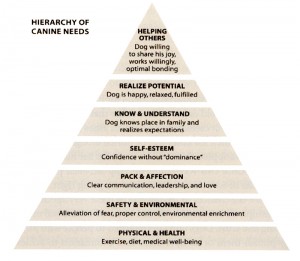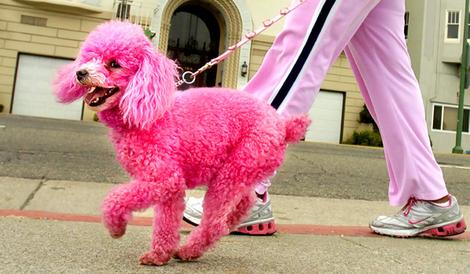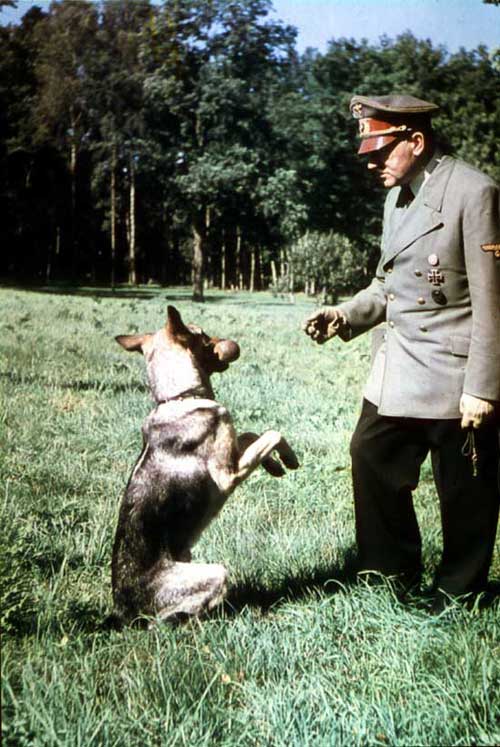Best, Short Dog Book Ever – Nicholas Dodman’s “The Well-Adjusted Dog”
March 17, 2009
 Dr. Nicholas Dodman, Director of the Animal Behavior Clinic at the Cumming School of Veterinary Medicine at Tufts University has produced a small gem of a book, The Well-Adjusted Dog.
Dr. Nicholas Dodman, Director of the Animal Behavior Clinic at the Cumming School of Veterinary Medicine at Tufts University has produced a small gem of a book, The Well-Adjusted Dog.
There’s more good, solid information in its 250 pages than in a whole host of other books written by dog ‘experts’ who have little or no credentials in the science and study of canines (Cesar Milan, I’m looking at you).
“Your job as a dog owner,” Dodman writes “is to try and understand your dog’s life fro his point of view, and to lead and protect, not to dominate, punish, and force a dog into submission, as popularized on too many of today’s TV shows.”
When this book comes out in paperback, I can see giving out multiple copies to neighbors and fellow dog owners, rather than trying to answer their questions myself.
One of the first and most vital points he makes is his belief that most dogs are under-exercised and bored out of their minds. (From my own experience I think this analysis is on the money). This leads to a multitude of behavioral problems including barking, inappropriate chewing, aggression, tail chasing, licking to the point of skin damage and more.
The average dog needs a minimum 30 minutes of aerobic exercise a day, every day. How many dogs do you know that meet that requirement?
Given that behavioral problems are the primary reason dogs are surrendered to shelters (the majority of whom are fated for euthanasia/destruction) proper handling of these issues may be essential to save the life of someone’s pet.
What I especially appreciate is his easy prose style and the clarity of his thinking even in controversial areas like herbal treatments and nutraceuticals. Here’s a sample of his writing about alternative medicine for dogs:
“Homeopathy—wherefore art thou, homeopathy? Though it’s popular in Europe, I have serious concerns about this branch of alternative medicine. The theory, of course, is that a little does of what ails you does you good. I can see how the concept applies to vaccination and desensitization to allergens, because inoculates stimulate an immune response—but I can’t see how it applies in other situations. Various homeopathic behavioral remedies containing microscopic concentrations of herbal products are now on the market.”
“One such remedy — anti-anxiety drops— was originally developed by an Irish veterinary practitioner who whipped up a dilute concoction of herbs to treat mastitis (inflammation of the udder) in cows. Being a large-animal vet, cows and mastitis were dear to his heart. In a moment of brilliance, he decided to bottle the cattle remedy for use in dogs to treat what else but . . .anxiety. And thus anti-anxiety drops were created. Whether the product actually works is doubtful, but bottles of the stuff are flying off the shelves. Naturopaths are positively swarming for it. Testing of this product presumably went like this:
- Take a worried-looking, baking dog and film him.
- Put the anxiety drops on his tongue.
- Wait until he has calmed down.
- Film him again.
- He’s calm.
- It’s a miracle!
The point they seemed to miss is that the only mental state that can follow a disturbed one is calm. It’s just a matter of time. I sent a sample of the anti-anxiety drops to the Department of Biochemistry and Experimental Therapeutics at Tufts medical school to see whether I ws missing something about the ingredients. The reply came back, ‘Nick, there’s virtually nothing here. It’s water.’ I guess that’s the point.”
Dodman also has constructed a pyramid Hierarchy of Canine Needs (adapted from psychologist Abraham Maslow’s triangle of human needs) that neatly summarizes what you as a caring dog owner should be striving towards. See how close you are coming to these goals with your own dog. Click image for larger size.
The bottom line: Buy This Book!
Using Your Dog to Find Love
February 23, 2009
“A lot of people are more emotionally touched when you do something for their pet, more than if someone brings flowers on the first date,” says Stephanie LaFarge, director of counseling services for the ASPCA and an expert on the human-animal bond.
In Heavy Petting: When animals dog a new relationship the AP’s Linda Lombardi writes about the issues (read: conflicts and connections) that modern singles with pets are coping with today.
 Leashes and Lovers is an online community devoted to connecting dog lovers for friendship and possibly more. I can certainly think of worse ways to start a relationship. At least this one doesn’t involve alcohol.
Leashes and Lovers is an online community devoted to connecting dog lovers for friendship and possibly more. I can certainly think of worse ways to start a relationship. At least this one doesn’t involve alcohol.
Kids, go ask your parents how wasted they were when they first met at that club/bar/party/wedding. See how well that worked out for them?
Having a mutual interest in canines might be a better foundation to build a life together. It’s not weird or sick like Litterboxes & Lovers, Where Crazy Cat Ladies Meet their Disturbing Male Counterparts, for example.
Update 2/24: But there’s a great deal more than just connecting with other dog lovers available on the Leashes and Lovers site — Blogs, Forums, a Directory of Dog Products & Services, Training Advice & Tips, Photos, Videos, News, Events, an E-zine and more. So you don’t have to be a dating single to use the many resources on this site.
I’d say that this is another example of the ongoing development of contemporary Dog Culture, like The BARK magazine. For thousands of years dogs have been an integral part of human society as partners, work mates and companions. Today they are being recognized for their important contributions to our lives in ways that highlight this as never before. Now go hug your dog and give her a treat — she deserves it!
Dogs and Autistic Children
April 2, 2008
Here’s a story we’d like desperately to believe is true: the benefits of service dogs assisting parents raising autistic children.
The evidence so far is anecdotal but heartfelt and persuasive; we’d love to see a double-blind study back up these wonderful stories with some hard data.
Parents claim that specially trained service dogs help make their autistic children “calmer, more social and more comfortable in the world.” The problem with self-reporting like this is that the parents are hardly disinterested parties and they’re not trained observer’s to boot.
The wife of a friend who works with autistic children has told me how eagerly they call her to report some sign of progress. But when she had her next session with the child the ‘breakthrough’ was just. . . a misinterpretation, wishful thinking, something you want so badly that you convince yourself you’ve seen it even though it was never there.
I must admit that I’m not a disinterested party either. I would very much like this be true. Helping a severely disabled child and giving rewarding work and love to a canine, what’s not to like. But we must be careful not to impose our wishes on reality. A case in point is the Facilitated Communication fiasco of a few years back.
The story here was that acutely disabled people, mostly children, could communicate if a trained person helped move their hand where they intended it to go on a keyboard or another surface with multiple options. It turned out to be wishful thinking and self-delusion when subjected to properly controlled conditions. Unconsciously, the facilitators were the ones providing both the intelligence and communication, not the subjects.
There’s something called the ideomotor effect, the kind of phenomenon that is behind such things as dowsing rods and Ouija boards. Your motor control is influenced without your awareness and the only information thus obtained comes from the user, not their environment or the Spirit World.
So the fact that I want this to be true makes me call all the more strongly for independent verification. College of Veterinary Medicine at Cornell University, are you reading this?
You know, instead of buying a hand-embroidered suede lounge cushion “Lotus Bed” for your dog (see previous post “Doga: Dog Yoga”) I’d ask you to please send that money to 4 Paws for Ability.
Their mission is to enrich the lives of people with disabilities by training and placing service animals to provide companionship and promote independent living.
Your dog doesn’t need a luxury Lotus Bed (trust me on this one), and these good folks could use your support to help make a real difference in people’s lives.
Unless you think that buying a Shanti stick inscribed with the mantra of Peace for your pooch is a better deal.
Leather Leashes vs. All Others – Part 1
March 27, 2008
I’ve always found that a six foot leather leash — nothing fancy, but something well made with brass fixings and reinforced stitching — is my favorite, as many times as I’ve used other leashes.
I never thought I would be one of those dog owners with an extendo-leash, the kind that has a hard rubber or plastic shell with a hand grip and a tough woven fabric 16 foot leash like the Flexi Soft Grip Comfort 1 retractable Cord Leash.
I’d see other people using them, or misusing them, barely keeping their dogs under control, and I formed a prejudice against ’em. These people were not ‘managing their dogs.”
It’s a line that has been drilled into my head by my favorite dog trainer, “Manage your dog.” I’m responsible for my dog’s safety and well-being. I should teach her good, polite behaviors and enforce them whenever we are outside or when company arrives. Any failure, any slice of wanton household destruction, any breach of protocol that puts my dog in jeopardy IS MY FAULT because I’m not properly Managing my Dog.
We recently added a new pooch to our permanent pack, Luna, a black female American style Labrador. Huxley, our chocolate Lab will be 6 this year. Our best guess about Luna is that she’s somewhere between 18 months and 2 years. After several months it became clear that her presence was having some effects on Huxley.
There were two noticeable behaviors: he began drinking exclusively from ‘her’ water bowl. And when we made the trip from out side door to our back yard – essentially the width of our one-car garage — he began asserting his independence by wandering down the drive way to pee over by our over-sized Christmas tree.
Next he’d saunter over to our 90 year old neighbor’s house across the street, position himself in the middle of her front lawn, squat and take a huge dump for all the passersby to see. He loves our neighbor Peg and she loves him and he wanted the world to know he was leaving her a brown token of his affection. Worse yet was when he’d lope across Prospect Drive and obliviously put himself in the path of mini-vans & SUVs.
There could not be a more public demonstration of my failure to Manage My Dog. And Huxley, is, by general consensus, a well-trained, polite canine. My analysis: He knows his behavior is transgressive and he persists because I believe it is status-related. She has to go right into the back yard to do her business while I, being senior, have more freedom than her! This independence is a part of Huxley’s character, he’s not your velcro-dog type at all.
But when this recently led to Huxley nearly getting hit by a van, I was totally freaked out, heart pounding, breath coming in short hyperventilating bursts — and resolved to get back to leashing him AT ALL TIMES!
Fortunately, the circumstances were all in our favor that morning. It was broad daylight, I was a few feet behind Huxley with a leash and a treat, yelling his name. The driver clearly saw both of us and slowed to a stop as I rushed passed, yelled jumbled apologies and gratitude over my shoulder, and continued after Huxley.
I was clearly Not Managing My Dog. I was failing spectacularly to Manage My Dog, in fact. This was my well-trained, polite Labrador? The one who never before was adamant about refusing to take that short walk across our drive way in the back yard, the fenced and secure and happy back yard? This starts happening when it becomes clear that Luna is here to stay and not another one of our many foster dogs; clearly her presence must be the triggering factor? Robert Park, author of the terrific Voodoo Science would say my belief engine is going into over drive here.
***
Disclaimer: I cringe when people anthropomorphize their dogs, but find that it is an impossibility for me to to completely avoid. All such statements should be understood in this context. It helps me to parse my beast’s behavior in terms that I can understand.
This interpretation is my own invention and may or may not correspond with the internal analytics going on in my dog’s brain. That it’s useful for me does not equate with its accuracy for representing Huxley’s thinking. I do think Huxley is thinking. I’m convinced of it.
I’m equally convinced that our mental syntax is so different, canine to primate, that all my interpretations of his internal mental states should be offered only as heavily qualified guesses.
***
But we talking about leather leashes and extendo-leashes, weren’t we? We now own two extendo-leashes and I’ve learned how to operate them without slicing off my own (or anyone else’s) fingers and extremities or causing blindness to anyone. Yet. These are some of the actual cautions from the packaging. Seriously, you wouldn’t want to be on the receiving end if your dog’s collar came loose and the ribbon and metal clasp were speeding rapidly back to you.
They do certainly give your dog more freedom to explore further away from you. But you have to pay attention and anticipate when you want to draw your dog nearer because she is always more than an arm’s length away. These extendo-leashes can be used properly, even if many people operate them at the far end of the safety spectrum.
But for control and all around functionality give me the dead animal skin every time.
More to Come
Dogs in China: Pets and Cuisine or “To Animals, all People are Nazis.”
March 18, 2008
Nobel Prize winner Isaac Bashevis Singer put his own feelings into one of his characters when he wrote: “In relation to [animals], all people are Nazis. For [them], it is an eternal Treblinka.”
The International Herald Tribune has an article on dogs in China, as pets and cuisine, here.
Once considered decadent and restricted by the Communist Party leadership, pet ownership in China is now expanding along with its huge middle class. Dog ownership used to be seen as ‘Western,’ politicly incorrect and license fees remain extremely expensive. To have a pet dog in China today is to make a statement: “I have enough abundance that I can conspicuously waste some on a pet (see Veblen below the fold, text beginning “The dog has advantages in the way of uselessness. . .”).
To Western eyes this throws into greater relief the distinction the Chinese see between canines as pets and canines as food. Large, mixed breed dogs are preferred for the kitchen, while small dogs are the current companion animal of choice. About 120 restaurants in Beijing offer dog on their menus.
“In Beijing, there’s a huge market with pitiful dogs waiting in cages to be sold as meat, and literally a few yards away standard poodles dyed in all colors of the rainbow,” said Jill Robinson, chief executive of Animals Asia Foundation, an animal welfare charity based in Hong Kong.
If we are shocked by this Chinese double standard, consider how we American’s treat the domestic pig. Viet Namese pot-bellied pigs are highly intelligent, some claim even smarter than dogs. They are said to be impeccably clean by nature, personable, curious, and playful. These pigs can be trained to the equivalent of basic dog training: house trained, leash trained, even learning a few tricks.
Yet almost no Americans have pigs as pets because we love to eat crispy fried bacon, Virginia ham and pulled-pork sandwiches. So instead of sharing our homes with them, we raise them in factory farms under horrifying conditions.
The thought of raising dogs in such conditions makes me ill; it’s the stuff of nightmares. It would be worse than any puppy mill in existence, and those are pretty bad places. But only because I’m conditioned by my culture to accept the agony of pigs. So how I can I pass judgement on the Chinese for eating what to their eyes are ugly, unwanted, yet tasty dogs? Around 300,000 a year are raised, killed, cooked and served; generally roasted, or in a stew or casserole.
The traditional Chinese belief system has many negative associations with dogs; they are synonymous with the dregs of society, or seen as pawns, boot lickers, and bound servants. There is no Chinese Lassie.
There is one positive folk belief concerning eating dog: that it has medicinal benefits. Such as improving blood circulation to allegedly keep you warmer in winter (a nice conflation of magical thinking and the warmth of a ‘three dog night’).
Despite all the attention being paid to the worldwide growth of Muslim fundamentalism, the meat with the largest growing demand from global consumers is pork. The reality is that to meet this demand the factory farming of pigs will have to increase exponentially. Hundreds of millions have been killed and hundreds of millions more will die instead of being personable, curious, and playful.
Is it unfair to call this an animal holocaust? It would certainly qualify for me, if it was dogs instead of pigs.
Hitler and Blondie
February 2, 2008
Hitler loved his dog Blondie. A dog trainer had schooled Blondie so well that Hitler was in awe of the precocious canine’s discipline and intelligence. What particularly amazed him — and he delighted in showing this to guests — was how Blondie would sing on command. He’d say, “Sing, Blondie,” and the dog would emit a yodel-like howl. But that is not all. He would then say, “Lower, Blondie,” and his beloved four-legged friend would drop an octave and “sing” in a deep tone “like Zarah Leander.”
All who surrounded Hitler knew of his pride and affection for Blondie. He bragged on the tricks she could perform. He kept her by his side most of the time. She even slept in his bedroom in the bunker. Then, as the Russians closed in, Hitler fed Blondie cyanide. He killed his dog not to spare her from any of the ravages which might follow defeat, not to spare her from hunger or deprivation or disease. Rather, he had begun to suspect that the cyanide Himmler had supplied for Hitler’s own suicide might be fake. So the Fuhrer, who had already sacrificed his entire nation to his own vanity, killed his dog to make sure that his supply of suicide tablets would work when the time came.
— testimony of Traudl Junge from the documentary, Im toten Winkel – Hitlers Sekretärin (Blind Spot – Hitler’s Secretary) 2002, directed by Andre Heller and Othmar Schmiderer. This documentary won top honors at the Berlin International Film Festival and the Chicago International Film Festival.
The AKC Canine Good Citizen Test: the details
February 2, 2008
Owning a dog has certainly become more complicated in the past twenty years. “Anti-dog legislation” prohibiting ownership of specific breeds in certain municipalities, no pets housing and the proliferation of “NO DOGS ALLOWED” signs in public places are just a few of the hurdles to be overcome by those who wish to own a canine companion.
In an effort to promote responsible dog ownership, The American Kennel Club conducts the Canine Good Citizen program to demonstrate that dogs, as companions of man, can be respected members of the community. The goals of the program are to educate dog owners about the benefits of well-behaved pets and demonstrate to the general public that dogs can be upstanding members in the community.
The Canine Good Citizen Program consists of a ten-step test which reproduces everyday situations which might be encountered by a dog and owner. The test is not competitive–each dog and owner team are individually assessed on a pass/fail basis for each of the steps. Dogs passing all ten steps receive a certificate from the AKC and are officially awarded the Canine Good Citizen title which gives the owner the right to use the letters “CGC” after his/her dog’s name.
Here is an outline of the CGC Test steps:
1. Accepting a Friendly Stranger
This test demonstrates that the dog will allow a friendly stranger to approach it and speak to its owner in a natural, everyday situation. The evaluator and owner will shake hands and exchange pleasantries. The dog must show no sign of resentment or shyness and must not break position or try to go to the evaluator.
2. Sitting Politely for Petting
This test demonstrates that the dog will allow a friendly stranger to touch it while it is out with its owner. The evaluator pets the dog and then circles dog and owner. The dog must not show shyness or resentment.
3. Appearance & Grooming
This practical test demonstrates that the dog will welcome being groomed and examined and will permit someone other than his owner to do so. It also demonstrates the owner’s care, concern and responsibility. The evaluator inspects the dog, then combs or brushes the dog lightly, examines the ears and each front foot.
4. Out for a Walk (on a loose leash)
This test demonstrates that the owner is in control of the dog. The dog must be on the left side of the owner, but need not be in the heel position. There must be a left turn, a right turn and an about turn with at least one stop in between and another at the end.
5. Walking Through a Crowd
This test demonstrates that the dog can move about politely in pedestrian traffic and is under control in public places. The dog may show some interest in the strangers, without appearing over exuberant, shy or resentful.
6. Sit and Down on Command/Staying in Place
This test demonstrates that the dog has training, will respond to the owner’s command to sit and down and will remain in place commanded by the owner. The owner may take a reasonable amount of time and use more than one command.
7. Coming When Called
This test demonstrates that the dog will come when called by the handler. The handler will walk 10 feet from the dog, turn to face the dog, and call the dog. The handler may use encouragement to get the dog to come. Handlers may choose to tell dogs to “stay” or “wait” or they may simply walk away, giving no instructions to the dog as the evaluator provides mild distractions (e.g. petting).
8. Reaction to Another Dog
This test demonstrates that the dog can behave politely around other dogs. Two owners and their dogs approach each other from a distance of about ten yards, stop, shake hands and exchange pleasantries, and continue on for about five yards. The dogs should show no more than a casual interest in each other.
9. Reactions to Distractions
This test demonstrates that the dog is confident at all times when faced with common distracting situations. The dog may express a natural interest and curiosity and may appear slightly startled, but should not panic, try to run away, show aggressiveness or bark.
10. Supervised Separation
This test demonstrates that the dog can be left with a trusted person, if necessary, and will maintain its training and good manners. Evaluators are encouraged to say something like, “Would you like me to watch your dog?” and then take hold of the dog’s leash. The owner will go out of sight for 3 minutes. The dog does not have to stay in position, but should not continually bark, whine or pace unnecessarily, or show anything stronger than mild agitation or nervousness.
Tellington Touch: “It’s Important to Believe that You’re Really Doing It.”
February 1, 2008
Toby was a young, enthusiastic dog. He had a hard time focusing and was reactive to all kinds of things, including other dogs, and unresponsive to training. His owners were frustrated. When Debby Potts first met Toby, she made note of the fact that his tail had been docked.
She began working on him, using different TTouch techniques. When she started to work on his “phantom tail” – the space where his tail used to be – he turned around to look at her as if he were curious about what she was doing. Potts did TTouches on the existing stump of the tail, and then continued beyond the physical tail into the air where the tail would be had it not been amputated.
“It’s amazing how many dogs with docked tails really clamp it to their body,” says Potts. She recommends gently working with all docked tails, even if there is just one vertebra, to ease the tension. Over and over she has seen noticeable changes in dogs, in their bodies, movement, and demeanor after working with their existing and phantom tails.
After Toby’s session, he was more focused, able to stand in balance, and less likely to pull on his leash. “It’s not uncommon for a dog to act more balanced after this kind of work,” says Potts. She does add that she hasn’t ever just worked on the tail or other amputated part of an animal, but regularly sees a clear reaction from dogs when working on their phantom parts, such as how Toby responded by looking at what she was doing.
This can look a little odd, Potts admits. “When I teach people how to work on their dog’s phantom parts, I usually suggest they do it in the privacy of their own homes!” She adds that it’s important to believe that you’re really doing it and can “see” the tail as if it were there. Just moving the hand and fingers around the area doesn’t have the same impact, she says.
The Whole Dog Journal
Debby Potts,TTouchInstructor/Practitioner,Licensed Veterinary Technician,The Integrated Animal, Portland, Oregon integratedanimal.com (503) 704-7499




